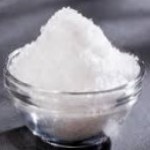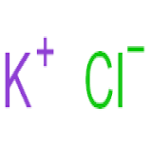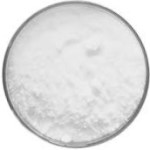Potassium Chloride & Potassium Iodide USP BP Ph Eur IP Reagent FCC Food Grade Suppliers Exporters, Manufacturers
Potassium Chloride
CAS Number: 7447-40-7 USP BP Ph Eur IP Reagent FCC Food Grade Suppliers Exporters, Manufacturers

Please visit Safety Data Sheet of Potassium Chloride USP BP Ph Eur IP Reagent FCC Food Grade Manufacturers.
Specifications of Potassium Chloride USP Grade
KCl --- 74.55
Assay: Potassium Chloride contains not less than 99.0 percent and not more than 100.5 percent of KCl, calculated on the dried basis.
Identification: A solution (1 in 20) responds to the tests for Potassium and for Chloride.
Acidity or alkalinity: To a solution of 5.0 g in 50 mL of carbon dioxide–free water add 3 drops of phenolphthalein: no pink color is produced. Then add 0.30 mL of 0.020 N sodium hydroxide: a pink color is produced.
Loss on drying: Dry it at 105 for 2 hours: it loses not more than 1.0% of its weight.
Iodide or bromide:
IODIDE: To pass the test. -- the limit is 0.005%.
BROMIDE: To pass the test. -- the limit is 0.1%.
Aluminum: where it is labeled as intended for use in hem dialysis to pass the test: --- the limit is 1 µg per g.
Calcium and magnesium: To 20 mL of a solution (1 in 100) add 2 mL each of 6 N ammonium hydroxide, ammonium oxalate and dibasic sodium phosphate: no turbidity is produced within 5 minutes.
Sodium: A solution (1 in 20), tested on a platinum wire, does not impart a pronounced yellow color to a non-luminous flame.
Heavy metals: Dissolve 2.0 g in 25 mL of water: the limit is 0.001%.
Organic volatile impurities: meets the requirements.
Specifications of Potassium Chloride BP Ph Eur Grade
KCl 74.55
DEFINITION
Content: 99.0 per cent to 100.5 per cent of KCl (dried substance).
CHARACTERS
Appearance: White or almost white, crystalline powder or colorless crystals.
Solubility: Freely soluble in water, practically insoluble in anhydrous ethanol.
IDENTIFICATION
It gives the reactions of chlorides.
Solution S gives the reactions of potassium.
TESTS
Solution S: Dissolve 10.0 g in carbon dioxide-free water prepared from distilled water and dilute to 100 ml with the same solvent.
Appearance of solution: Solution S is clear and colorless.
Acidity or alkalinity: To 50 ml of solution S add 0.1 ml of bromothymol blue solution. Not more than 0.5 ml of 0.01 M hydrochloric acid or 0.01 M sodium hydroxide is required to change the color of the indicator.
Bromides: Maximum 0.1 per cent.
Iodides: Moisten 5 g by the drop wise addition of a freshly prepared mixture of 0.15 ml of sodium nitrite solution, 2 ml of 0.5 M sulphuric acid, 25 ml of iodide-free starch solution and 25 ml of water. After 5 min, examine in daylight. The substance shows no blue color.
Sulphates: Maximum 300 ppm.
Aluminium: Maximum 1.0 ppm, if intended for use in the manufacture of hem dialysis solutions.
Barium: To 5 ml of solution S add 5 ml of distilled water and 1 ml of dilute sulphuric acid. After 15 min, any opalescence in the solution is not more intense than that in a mixture of 5 ml of solution S and 6 ml of distilled water.
Iron: Maximum 20 ppm.
Magnesium and alkaline-earth metals: Maximum 200 ppm, calculated as Ca.
Sodium: Maximum 0.10 per cent, if intended for use in the manufacture of parenteral preparations or hem dialysis solutions.
Heavy metals: Maximum 10 ppm.
Loss on drying: Maximum 1.0 per cent, determined on 1.000 g by drying in an oven at 105 C for 3h.
Specifications of Potassium Chloride IP Grade:
Dry Basis Assay (KCl): 99.0% Potassium Chloride
Description: White, crystalline powder, odorless.
Solubility: Freely soluble in water; sparingly soluble in ethanol (95%).
Matter Insoluble in Water: Clear & colourless solution (10% KCl w/w).
Acidity or Alkalinity: Passes the Test
Barium: Passes the Test
Arsenic: 1 ppm max.
Iron: 20 ppm max.
Calcium & Magnesium: Passes the Test
Sulphate: 300 ppm max.
Heavy Metals: 10 ppm max.
Bromide: 0.1%
Iodide: Passes the Test
Loss on Drying: 1.0% max.
Specifications of Potassium Chloride FCC Food Grade
KCl -- 74.55
DESCRIPTION: Potassium Chloride occurs as colorless, elongated, prismatic, or cubical crystals, or as a white, granular powder. It is stable in air. Its solutions are neutral to litmus. It may contain up to 1.0% (total) of suitable food-grade ant-caking, free-flowing, or conditioning agents such as calcium stearate or silicon dioxide, either singly or in combination. One gram dissolves in 2.8 mL of water at 25C and in about 2 mL of boiling water. Potassium Chloride containing anti-caking, free-flowing, or conditioning agents may produce cloudy solutions or dissolve incompletely. It is insoluble in alcohol.
Function: Nutrient; gelling agent; salt substitute; yeast food.
REQUIREMENTS:
Identification: A 1:20 aqueous solution gives positive tests for Potassium and for Chloride.
Assay: Not less than 99.0% of KCl after drying; and not less than 98.0% of KCl after drying when a sample contains added substance.
Acidity or Alkalinity: A sample containing no added substance passes test.
Heavy Metals (as Pb): Not more than 5 mg/kg.
Iodide and/or Bromide: Passes test.
Loss on Drying: Not more than 1.0%.
Sodium: Passes test.
Potassium Chloride Analytical Reagent Grade Specifications
Formula Weight 74.55
CAS Number 7447-40-7
REQUIREMENTS
Assay: 99.0-100.5% KCl
pH of a 5% solution: 5.4-8.6 at 25C.
MAXIMUM ALLOWABLE
Insoluble matter: 0.005%
Iodide (I): 0.002%
Bromide (Br): 0.01%
Chlorate and nitrate (as NO3): 0.003%
Nitrogen compounds (as N): 0.001%
Phosphate (PO4): 5 ppm
Sulfate (SO4): 0.001%
Barium (Ba): Passes test
Heavy metals (as Pb): 5 ppm
Iron (Fe): 3 ppm
Calcium (Ca): 0.002%
Magnesium (Mg): 0.001%
Sodium (Na): 0.005%..

Please visit Hazard Statement of Potassium Chloride USP BP Ph Eur IP Reagent FCC Food Grade Suppliers.
Potassium Iodide
CAS Number: 7681-11-0 USP BP Ph Eur IP Reagent FCC Food Grade Suppliers Exporters, Manufacturers

Please visit Safety Data Sheet of Potassium Iodide USP BP Ph Eur IP Reagent FCC Food Grade Manufacturers.
Potassium Iodide USP Grade Specifications:
KI --- 166.00
Potassium iodide CAS 7681-11-0
DEFINITION
Potassium Iodide contains NLT 99.0% and NMT 101.5% of KI, calculated on the dried basis.
IDENTIFICATION
A. Identification Tests-General, Potassium: Meets the requirements
B. Identification Tests-General, Iodide: Meets the requirements
ASSAY
Procedure
Sample solution: Dissolve 500 mg of Potassium Iodide in 10 mL of water.
Analysis: Add 35 mL of hydrochloric acid to the Sample solution, and titrate with 0.05 M potassium iodate until the dark brown solution that is produced becomes pale brown. Add 2–3 drops of amaranth and continue the titration slowly until the red color just changes to yellow. Each mL of 0.05 M potassium iodate is equivalent to 16.60 mg of KI.
Acceptance criteria: 99.0% to 101.5% on the dried basis.
Iodate solution: Dilute 1 mL of potassium iodate solution (1 in 2500) with water to 100 mL.
Standard solution: Dissolve 100 mg of Potassium Iodide in ammonia- and carbon dioxide-free water and add 1 mL of Iodate solution to obtain 10 mL of solution. Transfer to a color-comparison tube, add 1 mL of starch and 0.25 mL of 1.0 N sulfuric acid, and mix.
Sample solution: Dissolve 1.1 g in sufficient ammonia- and carbon dioxide-free water to obtain 10 mL of solution. Transfer to a color-comparison tube, add 1 mL of starch TS and 0.25 mL of 1.0 N sulfuric acid, and mix.
Acceptance criteria: Any color produced in the Sample solution does not exceed that produced in the Standard solution (NMT 4 µg/g).
Limit of Nitrate, Nitrite, and Ammonia:
Sample solution: Dissolve 1 g in 5 mL of water.
Analysis: To the Sample solution contained in a test tube of 40-mL capacity add 5 mL of 1 N sodium hydroxide and 200 mg of aluminum wire. Insert a pledget of purified cotton in the upper portion of the test tube and place a piece of moistened red litmus paper over the mouth of the tube. Heat the test tube and its contents in a steam bath for 15 min.
Acceptance criteria: No blue coloration of the paper is discernible.
Thiosulfate and Barium:
Sample solution: Dissolve 0.5 g in 10 mL of ammonia- and carbon dioxide-free water.
Analysis: Add 2 drops of 2 N sulfuric acid.
Acceptance criteria: No turbidity develops within 1 min.
Alkalinity:
Sample solution: Dissolve 1.0 g of Potassium Iodide in 10 mL of water.
Analysis: Add 0.1 mL of 0.1 N sulfuric acid and 1 drop of phenolphthalein TS to the Sample solution.
Acceptance criteria: No color is produced.
Loss on Drying: Dry a sample at 105C for 4 h: it loses NMT 1.0% of its weight.
Packaging and Storage: Preserve in well-closed containers.
Specifications of Potassium Iodide BP Ph Eur Grade
KI -- 166.0 -- CAS 7681-11-0
Content: 99.0 per cent to 100.5 per cent (dried substance).
CHARACTERS
Appearance: White or almost white powder or colourless crystals.
Solubility: Very soluble in water, freely soluble in glycerol, soluble in ethanol (96 per cent).
IDENTIFICATION
A. Solution S (see Tests) gives the reactions of iodides (2.3.1).
B. Solution S gives the reactions of potassium (2.3.1).
TESTS
Solution S: Dissolve 10.0 g in carbon dioxide-free water R prepared from distilled water R and dilute to 100 ml with the same solvent.
Appearance of solution: Solution S is clear and colourless.
Alkalinity: To 12.5 ml of solution S add 0.1 ml of bromothymol blue solution R1. Not more than 0.5 ml of 0.01 M hydrochloric acid is required to change the colour of the indicator.
Iodates: To 10 ml of solution S add 0.25 ml of iodide-free starch solution R and 0.2 ml of dilute sulphuric acid R and allow to stand protected from light for 2 min. No blue colour develops.
Sulphates: Maximum 150 ppm.
Dilute 10 ml of solution S to 15 ml with distilled water R.
Thiosulphates: To 10 ml of solution S add 0.1 ml of starch solution R and 0.1 ml of 0.005 M iodine. A blue colour is produced.
Iron: Maximum 20 ppm.
Dilute 5 ml of solution S to 10 ml with water R.
Heavy metals: Maximum 10 ppm.
12 ml of solution S complies with test A. Prepare the reference solution using lead standard solution (1 ppm Pb) R.
Loss on drying: Maximum 1.0 per cent, determined on 1.00 g of previously powdered substance by drying in an oven at 105C for 3 h.
Specifications of Potassium Iodide IP Grade
KI -- Molecular Weight 166.00
Category: Antithyroid; antifungal; expectorant.
Description: Colourless crystals or white powder; odourless
Solubility: Very soluble in water; freely soluble in glycerin; soluble in ethanol (95%).
STANDARDS
Potassium Iodide contains not less than 99.0 per cent and not more than 100.5 per cent of KI, calculated with reference to the dried substance.
Identification: A 10% w/v solution in carbon dioxide-free water (solution A) gives the reactions of potassium salts and of iodides.
Alkalinity: To 10 ml of solution A add 0.2 ml of 0.01M sulphuric acid; no colour is produced on addition of a drop of PhPh solution. .
Clarity and colour of solution: Solution A is clear and colourless.
Arsenic: Dissolve 5.0 g in 50 ml of 'water and 12 ml of stannated hydrochloric acid AsT. The resulting solution complies with the limit test for arsenic (2 ppm).
Heavy metals: Not more than 10 ppm, determined on 2.0 g
Iron: Solution A complies with the limit lest for iron (20 ppm).
Barium: Dissolve 0.5 g in 10 ml of water and add 1 ml of dilute sulphuric acid; no turbidity develops within one minute.
Specifications of Potassium Iodide FCC Food Grade
KI Formula wt 166.00
CAS: 7681-11-0
DESCRIPTION
Potassium Iodide occurs as hexahedral crystals, either transparent and colorless or somewhat opaque and white, or as a white, granular powder. It is stable in dry air but slightly hygroscopic in moist air. One gram is soluble in 0.7 mL of water at 25C, in 0.5 mL of boiling water, in 2 mL of glycerin, and in 22 mL of alcohol.
REQUIREMENTS
Identification:
A. A 1:10 aqueous solution responds to the tests for Potassium and for Iodide.
B. The pH of a 1:20 aqueous solution is between 6 and 10.
Assay: Not less than 99.0% and not more than 101.5% of KI after drying.
Iodate: Not more than 4 mg/kg.
Lead: Not more than 4 mg/kg.
Loss on Drying: Not more than 1%.
Nitrate, Nitrite, and Ammonia: Passes test.
Thiosulfate and Barium: Passes test.
Specifications of Potassium Iodide Analytical Reagent Grade
KI -- Formula Weight 166.00
CAS Number 7681-11-0
REQUIREMENTS
Assay: Minimum 99.0% KI
pH of a 5% solution: 6.0-9.2 at 25C
MAXIMUM ALLOWABLE
Insoluble matter: 0.005%
Loss on drying at 150C: 0.2%
Chloride and bromide (as Cl): 0.01%
Iodate (IO3): 3 ppm
Nitrogen compounds (as N): 0.001%
Phosphate (PO4): 0.001%
Sulfate (SO4): 0.005%
Barium (Ba): 0.002%
Heavy metals (as Pb): 5 ppm
Iron (Fe): 3 ppm
Calcium (Ca): 0.002%
Magnesium (Mg): 0.001%
Sodium (Na): 0.005%.
Please visit Hazard Statement of Potassium Iodide USP BP Ph Eur IP Reagent FCC Food Grade Suppliers.
Potassium Chloride CAS Number 7447-40-7 & Potassium Iodide CAS Number 7681-11-0 Supplier Exporter, Manufacturer:
Annie Chemie P Ltd
Mumbai 4000010, INDIA
With Agents and offices in UAE, USA, Europe.
e-mail: info@anniechemie.com
Copyright and Usual Disclaimer is Applicable.
June 1, 2025
Exporters to USA, Canada, UK, Europe, UAE, Nigeria, Algeria, Turkey, Mexico, Brazil, Chile, Argentina, Australia, Dubai etc.
Perfection is made up of small things and that is a big thing.
